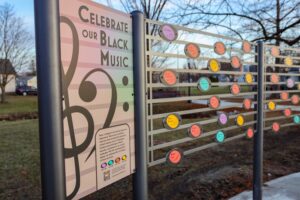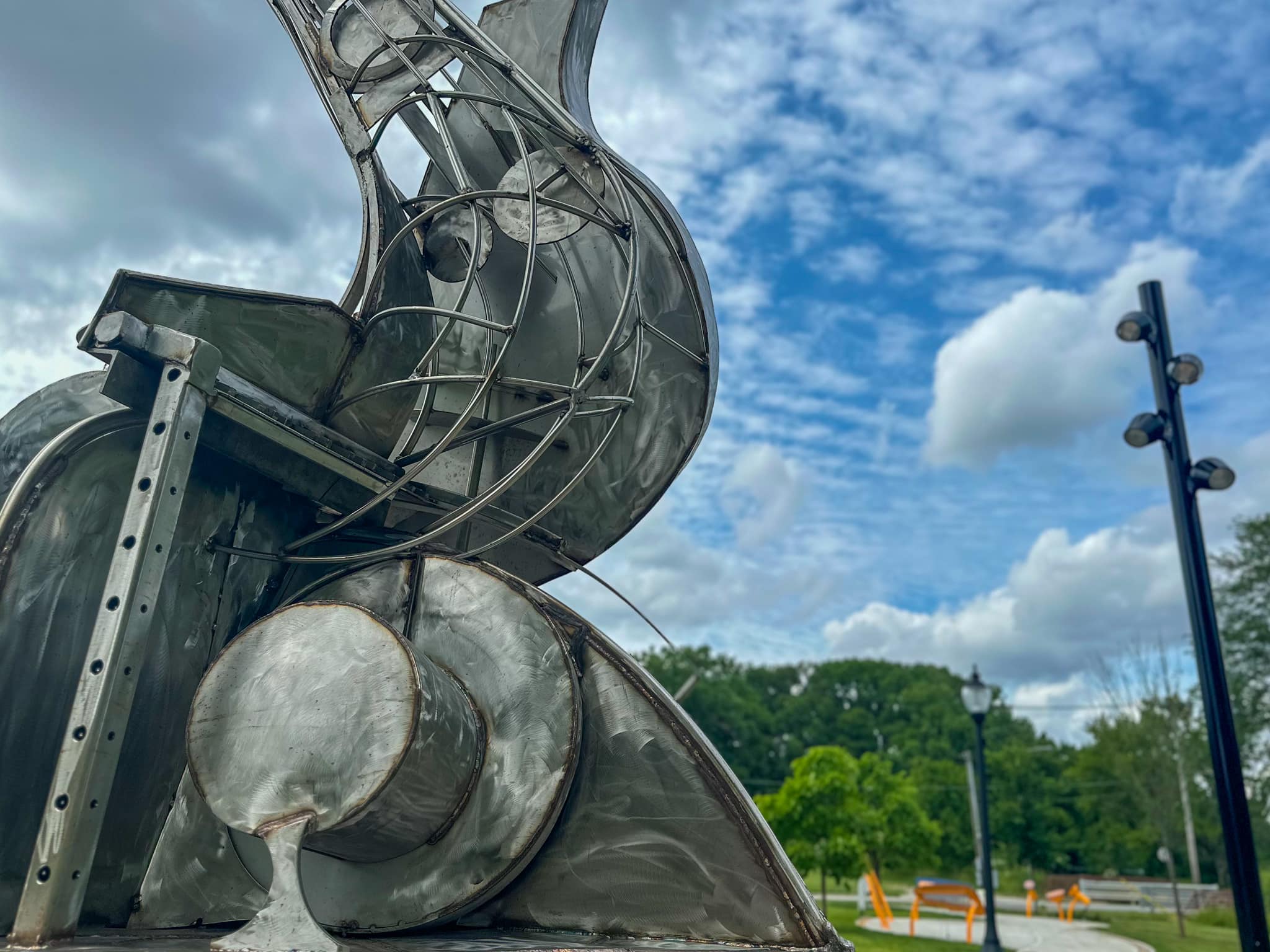Skelton Park
101 E. Washington St., Champaign
Skelton Park, a pocket park at the corner of N. First Street and E. Washington Street, is designed to pay homage to Champaign County's history of locally, nationally, and internationally recognized African American musicians.
Skelton Park was renovated in 2023 and 2024 as part of the Champaign County African American Heritage Trail with support from the Experience Champaign-Urbana Foundation, Champaign Park District, Rotary Club of Champaign, City of Champaign, Champaign County, and the Illinois Department of Commerce and Economic Opportunity. Co-Chairs of the Heritage Trail, Barbara Suggs Mason and Angela Rivers, as well as musician Nathaniel Banks were instrumental to the park’s design and development.
Its centerpiece is a sculpture by African American artist Preston Jackson that is designed to reflect a variety of musical instruments and genres of significance to local Black musicians. The sculpture is surrounded by a small plaza, lighting, a seating wall, and a sloped berm. Pathways invite residents and visitors to enter the park where they can play with interactive musical instruments and view bricks that were donated and inscribed by numerous community members to support the park’s development. A “Wall of Fame” sign that acknowledges specific African American musicians is planned for late 2024.
A ribbon cutting for Skelton Park was held on June 7, 2024. The event was attended by dozens of residents, supporters, and community members with connections to African American musicians from Champaign County.
 Celebrate Our Black Music
Celebrate Our Black Music
This monument in Skelton Park is in honor of the many Black musicians from the Champaign-Urbana area. Learn more about this project and how artists were selected. The following is a list of artists, by time period, with genre and primary instrument included (bios of all artists are underway):
1890s-1920s
Chester W. Brewer, March Music, Brass
Preston Bridgewater, Early Jazz, Coronet
Ray Hines, Early Jazz, Drums
Benjamin Franklin Nash, Early Jazz, Composer
George Washington Riley, March Music, Drums
Raymond “Mac” Scott, Jazz, Saxophone
1930s-1950s
Harold “Pete” Bridgewater, Jazz, Bass
Cecil Bridgewater Sr., Jazz, Trumpet
Earnest “Earnie” Hite, Jazz/R&B, Keyboard
Luster J. “Lus” Hite, Jazz, Drums
Jerry Lynch, Jazz
Cecil Pope, Sacred Music, Pipe organ
Ellen Rivers, Jazz, Keyboard
Jerry Graham Valentine, Jazz, trombone
Julia Walden Valentine, Classical, Keyboard (pianist)
Hattie Winfield, Classical, Vocalist
1960s-1980s
Steve Alexander, Jazz, Drums
Komala “Willie” Amoaku, Jazz, Master drummer
Darnell Banks, Jazz, Tenor sax
Deborah Banks, Sacred Music, Keyboard
Nathaniel Banks, Jazz, Trumpet
Dee Dee Bridgewater, Jazz , Vocals
Ron Bridgewater, Jazz, Reeds
Cecil Bridgewater Jr., Jazz, Trumpet
Barbara Burton, R&B, Vocals
Walter Burton, R&B, Vocals
Willie Burton, R&B, Keyboard
Vickie Capo, R&B, Vocals
Pauli Carman, R&B, Vocals
Russell E. Cheatham, R&B, Keyboard
Tom “TT” Coleman, R&B, Vocals
Ollie Watts Davis, Sacred Music, Vocalist
Alvin De Sayles, R&B, Vocals
Sylvia De Sayles, Jazz, Vocals
Wayne Easley, Sacred Music, Keyboard
William “Count Demon” Evans, Jazz, Drums
Freddie Fletcher, R&B, Vocals
Gerald “Candy” Foster, R&B, Vocals
Jimmy Hill, R&B, Keyboard
Walter “Jelly” Hines, Jazz, Drums
Louis Hite, Jazz/R&B, Drums
Elzie Howell, R&B, Tenor Sax
Carlyle Johnson, Jazz, Reeds
Francis Johnson, Jazz, Tenor sax
Earl Jones, R&B, Drums
Chester Knox, R&B, Keyboard
Leroy Knox, R&B, Vocals
Milton Curtis Knox, R&B, Keyboard
Bobby Lane, R&B, Guitar, Director
Eddie Lane, R&B, Drums, Director
Michael Lane, R&B, Keyboards
Ricky Lane, R&B, Drums
Lenard Leavell, R&B, Alto Saxophone
Terry Marshall, R&B, Keyboard
Charles McClain, Sacred Music, Keyboard
Eugene “Brother Jack” McDuff, Jazz, Keyboard
Maurice McKinley, Jazz, Drums
Billy McMullen, R&B, Drums
Roy Milton, Jazz,
Milton Norwood, March Music, Drums
Lamont Parsons, Jazz, Guitar
Clyde Perkins, R&B, Drums
Carla Peyton, R&B, Vocals
Robert Ray, Classical, Keyboard
Oscar Scully, Jazz, African Drums
Guido Sinclair, Jazz, Alto saxophone
Donald Smith, Jazz, Vocals
Barbara Suggs Mason, Classical, Vocalist
Willie T. Summerville, Sacred Music, Keyboard
Todd Taylor, Sacred Music, Keyboard
William Warfield, Classical, Vocalist
Larry Welch, R&B, Bass guitar
Tony Zamora, Jazz, Reeds
1980s-2020s
Christopher Brian (Ludacris) Bridges, Hip Hop, Vocals
Noah I. Brown, Sacred Music, Keyboard
Charlie Butts, Sacred Music, Keyboard
Ryan Byfield, R&B, Keyboard
Dawn Clark, R&B, Vocals
Mary Clark, R&B, Vocals
Barrington Coleman, Classical, Vocalist
Steve Davis, Sacred Music, Keyboard
Sam Hankins, Jazz, Trumpet
Cynthia Haymon, Classical, Vocalist
Kevin Hines, Sacred Music, Keyboard
Lamont Holden, Hip Hop,
Clarence Hudson, R&B, Keyboard
Christopher Lane, R&B, Guitar
William “Will” Patterson, Hip Hop
Danny Phillips, R&B, Drums
Sandy Phillips, R&B, Vocalist
James Pryor, Jazz, Keyboard
Rochelle Sennet, Classical, Keyboard
Eugene Washington, Sacred Music, Keyboard
Brenda Williams, Classical, Vocalist
Margaret Porter Wright, Sacred Music, Keyboard
Decade:
2020-2029
Location(s):
- Champaign, Illinois
Additional Champaign Trail Sites

